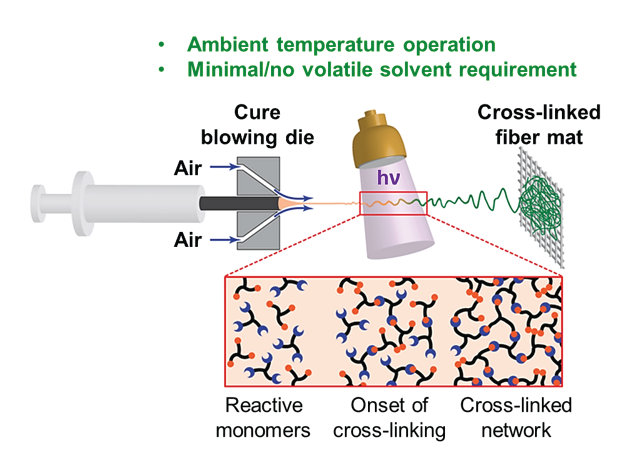(334y) Cross-Linked Nonwoven Fibers By Room-Temperature Cure Blowing and in Situ Photopolymerization
AIChE Annual Meeting
2020
2020 Virtual AIChE Annual Meeting
Meet the Candidates Poster Sessions
Meet the Industry Candidates Poster Session: Pharmaceutical Discovery, Development and Manufacturing Forum
Tuesday, November 17, 2020 - 8:00am to 9:00am
Micron-sized nonwovens serve a diverse range of applications such as medical textiles, geotextiles, filtration media, etc. Current methods for producing synthetic nonwovens rely on transforming pre-formed thermoplastic polymers by heating or adding organic solvents to facilitate drawing, which respectively results in their high energy demands and concerns about volatile solvent emissions. Furthermore, conventional synthetic fiber manufacturing is limited to thermoplastics since cross-linked thermosets do not flow like liquids. However, cross-linked (thermoset) fibers are attractive targets due to their superior thermal and chemical resistances. Herein, we describe a “cure blowing†process that addresses these issues by producing cross-linked fibers at room temperature with little or no volatile solvent. In this process, a photocurable liquid mixture of thiol and acrylate monomers was extruded through a spinning die resembling those used for commercial melt blowing and drawn into liquid filaments by high-velocity, ambient temperature air jets. The liquid filaments were cross-linked in flight into solid fibers by in-situ photopolymerization. Studies of the effects of process parameters on the fiber diameter and morphology revealed two inherent process limits: (1) a kinetic limit dictated by rate of photopolymerization relative to fiber fight time, and (2) a stability limit dictated by the surface tension and viscoelasticity of the monomer mixture. These limits manifest as fibers that are fused at their points of contact or fibers that possess surface undulations and non-uniform diameters, respectively. Several strategies to suppress or delay these limits were also identified and demonstrated experimentally to expand the cure blowing process window. Furthermore, we observed that the various parameters involved in cure blowing govern the final fiber characteristics in a convoluted and inter-dependent manner. A comprehensive analysis in terms of a few characteristic timescales corresponding to the different competing features of the process was also performed. This analysis led to the development of an universal operating diagram for cure blowing. This diagram can be used as a predictive process design tool where all the parameters of a new reactive system can be tuned a priori of fiber production. This will essentially eliminate the need to determine the appropriate process conditions through many trial-and-error experiments. These studies suggest the industrial relevance of this new cure blowing technique for producing cross-linked synthetic nonwovens for a wide range of applications.
Topics
Checkout
This paper has an Extended Abstract file available; you must purchase the conference proceedings to access it.
Do you already own this?
Log In for instructions on accessing this content.
Pricing
Individuals
| AIChE Pro Members | $150.00 |
| AIChE Emeritus Members | $105.00 |
| AIChE Graduate Student Members | Free |
| AIChE Undergraduate Student Members | Free |
| AIChE Explorer Members | $225.00 |
| Non-Members | $225.00 |
